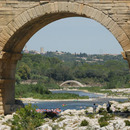Biography
Born in Tokyo in 1957, Shigeru Ban attended the Southern California Institute of Architecture and the Cooper Union School of Architecture where he graduated in 1984 while working for Arata Isozaki.
In 1985, he opened his own firm in Tokyo and began a busy professional, teaching and scientific career. He was Adjunct Professor of Architecture at Yokohama National University for five years and Adjunct Professor of Architecture at Nihon University for four years.
He is also a visiting professor at Columbia University and an Honorary Fellow at the American Institute of Architects (HFAIA) and at the Royal Architectural Institute of Canada (HRAIC). He has been teaching at Kyoto University of Art and Design since 2011.
His architectural style is known all over the world for the pioneering use of humble materials such as cardboard and bamboo, “blending traditional Japanese architecture with modernist teachings (...) and attaching his name to the design of temporary structures for the victims of natural disasters” (Treccani).
In 1995, he founded the NGO Voluntary Architects’ Network (VAN), an organization that helps people affected by devastating natural disasters by providing architectural solutions such as temporary housing, shelters, community centers and spiritual facilities.
He also won the Architecture for Humanity Award (USA) for the Paper Log House (1995), designed in response to the earthquake that struck the city of Kobe, Japan.
These low-cost, resistant and durable emergency housing units are made of a few dozen cardboard tubes with a 1-metre diameter and their foundations consist of beer crates filled with sand bags. The building is designed in such a way that it can be easily built and disassembled, and then reused.
With this construction technique, Ban also built the Takatori temporary church (1995) and the Japanese pavilion at the Expo 2000 in Hanover.
Other emergency interventions include the structures in the refugee camp in Rwanda (1999), built with a lattice system that allows quick and easy assembly; post-tsunami housing in Kirinda, Sri Lanka in 2004; and the L’Aquila Temporary Concert Hall (2011), with a cardboard structure and a lightweight truss roof.
He is constantly working in extreme contexts and is active all over the world: Ban is there “from the beginning in places of tragedy, including Rwanda, Turkey, India, China, Italy, Haiti and his country of origin, Japan”.
This significant contribution on his part is also one of the reasons he won the Pritzker Prize 2014. Summing up the key elements of his design philosophy, the jury stated: “a creative and innovative approach, especially with regard to materials and structures, is the common thread in all his works. Through excellent design, which addresses the most pressing challenges, Shigeru Ban has expanded the role of this profession, allowing architects to engage in dialogue with governments and public agencies, philanthropists and communities affected by catastrophic events”, thanks to the personal sense of responsibility and commitment to create high-quality architecture that meets the needs of society.
Ban has continued to use the tubes to create structures such as the Paper Arch (2000), a decorative lattice exhibited in the gardens of New York City’s Museum of Modern Art; the Paper Dome in Amsterdam/ Utrech (2003), a travelling theatre also made of cardboard tubes, with a spherical dome covered in polycarbonate; and the temporary paper office, located on the terrace of the new headquarters of the contemporary arts association Center Pompidou in Metz (2005).
He has won numerous awards over the years, including the Ordre national du Merite, the Urban Land Institute Awards for Excellence (finalist for the Kirinda Project, Sri Lanka) and the World Architecture Awards 2002 (Best House in the World, Naked House). Exhibitions of his works have been held in Japan, the USA and Europe. In 2013, he held a solo exhibition called “Shigeru Ban. Architecture and Humanitarian Activities”, Art Tower, Mito (Japan).
Shigeru Ban selected works and projects
- Tainan Art Museum, Taiwan, 2019
- Mt. Fuji Shizuoka Airport, Makinohara City (Giappone), 2019
- Centro commerciale Forest, Christchurch (Nuova Zekanda), in corso
- Shishi-iwa House, Karuizawa Town, (Giappone), 2018
- YUFUiNFO, Yufu, Oita (Giappone), 2018
- Mt. Fuji World Heritage Centre, Fujinomiya (Giappone), 2017
- Vin Sante + N House, Tokyo, (Giappone), 2016
- Aspen Art Museum, Aspen (USA), 2014
- Skolkovo Golf Club House, Mosca (Russia), 2014
- Paper Nursery School, Ya'an City (Cina), 2014
- Oita Prefectural Art Museum, Oita (Giappone), 2014
- Tamedia New Office Building, Zurigo (Svizzera), 2013
- Sengokubara S Residence, Kanagawa (Giappone), 2013
- Tamedia office building, Zurigo (Svizzera), 2013
- Cardbord Cathedral, Christchurch (Nuova Zelanda), 2013
- Hermes Pavilion, 2011
- Paper Concert hall, L’Aquila (Italia), 2011
- Centre Pompidou Metz, Metz (Francia), 2010
- Quinta botanica (Portogallo), 2009
- Paper dome, Taiwan, 2008
- Papertainer museum, Seul (Corea), 2006
- Abitazioni post-tsunami, Kirinda (Sri Lanka), 2004
- Paper Theatre, Amsterdam, Utrecht (Olanda), 2003
- Paper Arch - Museum of Modern Art, New York (USA), 2000
- Padiglione giapponese, Expo Hannover (Canada), 2000
- Paper church, Kobe (Giappone), 1995
- Paper log house, Kobe (Giappone), 1995
Official website
www.shigerubanarchitects.com
In 1985, he opened his own firm in Tokyo and began a busy professional, teaching and scientific career. He was Adjunct Professor of Architecture at Yokohama National University for five years and Adjunct Professor of Architecture at Nihon University for four years.
He is also a visiting professor at Columbia University and an Honorary Fellow at the American Institute of Architects (HFAIA) and at the Royal Architectural Institute of Canada (HRAIC). He has been teaching at Kyoto University of Art and Design since 2011.
His architectural style is known all over the world for the pioneering use of humble materials such as cardboard and bamboo, “blending traditional Japanese architecture with modernist teachings (...) and attaching his name to the design of temporary structures for the victims of natural disasters” (Treccani).
In 1995, he founded the NGO Voluntary Architects’ Network (VAN), an organization that helps people affected by devastating natural disasters by providing architectural solutions such as temporary housing, shelters, community centers and spiritual facilities.
He also won the Architecture for Humanity Award (USA) for the Paper Log House (1995), designed in response to the earthquake that struck the city of Kobe, Japan.
These low-cost, resistant and durable emergency housing units are made of a few dozen cardboard tubes with a 1-metre diameter and their foundations consist of beer crates filled with sand bags. The building is designed in such a way that it can be easily built and disassembled, and then reused.
With this construction technique, Ban also built the Takatori temporary church (1995) and the Japanese pavilion at the Expo 2000 in Hanover.
Other emergency interventions include the structures in the refugee camp in Rwanda (1999), built with a lattice system that allows quick and easy assembly; post-tsunami housing in Kirinda, Sri Lanka in 2004; and the L’Aquila Temporary Concert Hall (2011), with a cardboard structure and a lightweight truss roof.
He is constantly working in extreme contexts and is active all over the world: Ban is there “from the beginning in places of tragedy, including Rwanda, Turkey, India, China, Italy, Haiti and his country of origin, Japan”.
This significant contribution on his part is also one of the reasons he won the Pritzker Prize 2014. Summing up the key elements of his design philosophy, the jury stated: “a creative and innovative approach, especially with regard to materials and structures, is the common thread in all his works. Through excellent design, which addresses the most pressing challenges, Shigeru Ban has expanded the role of this profession, allowing architects to engage in dialogue with governments and public agencies, philanthropists and communities affected by catastrophic events”, thanks to the personal sense of responsibility and commitment to create high-quality architecture that meets the needs of society.
Ban has continued to use the tubes to create structures such as the Paper Arch (2000), a decorative lattice exhibited in the gardens of New York City’s Museum of Modern Art; the Paper Dome in Amsterdam/ Utrech (2003), a travelling theatre also made of cardboard tubes, with a spherical dome covered in polycarbonate; and the temporary paper office, located on the terrace of the new headquarters of the contemporary arts association Center Pompidou in Metz (2005).
He has won numerous awards over the years, including the Ordre national du Merite, the Urban Land Institute Awards for Excellence (finalist for the Kirinda Project, Sri Lanka) and the World Architecture Awards 2002 (Best House in the World, Naked House). Exhibitions of his works have been held in Japan, the USA and Europe. In 2013, he held a solo exhibition called “Shigeru Ban. Architecture and Humanitarian Activities”, Art Tower, Mito (Japan).
Shigeru Ban selected works and projects
- Tainan Art Museum, Taiwan, 2019
- Mt. Fuji Shizuoka Airport, Makinohara City (Giappone), 2019
- Centro commerciale Forest, Christchurch (Nuova Zekanda), in corso
- Shishi-iwa House, Karuizawa Town, (Giappone), 2018
- YUFUiNFO, Yufu, Oita (Giappone), 2018
- Mt. Fuji World Heritage Centre, Fujinomiya (Giappone), 2017
- Vin Sante + N House, Tokyo, (Giappone), 2016
- Aspen Art Museum, Aspen (USA), 2014
- Skolkovo Golf Club House, Mosca (Russia), 2014
- Paper Nursery School, Ya'an City (Cina), 2014
- Oita Prefectural Art Museum, Oita (Giappone), 2014
- Tamedia New Office Building, Zurigo (Svizzera), 2013
- Sengokubara S Residence, Kanagawa (Giappone), 2013
- Tamedia office building, Zurigo (Svizzera), 2013
- Cardbord Cathedral, Christchurch (Nuova Zelanda), 2013
- Hermes Pavilion, 2011
- Paper Concert hall, L’Aquila (Italia), 2011
- Centre Pompidou Metz, Metz (Francia), 2010
- Quinta botanica (Portogallo), 2009
- Paper dome, Taiwan, 2008
- Papertainer museum, Seul (Corea), 2006
- Abitazioni post-tsunami, Kirinda (Sri Lanka), 2004
- Paper Theatre, Amsterdam, Utrecht (Olanda), 2003
- Paper Arch - Museum of Modern Art, New York (USA), 2000
- Padiglione giapponese, Expo Hannover (Canada), 2000
- Paper church, Kobe (Giappone), 1995
- Paper log house, Kobe (Giappone), 1995
Official website
www.shigerubanarchitects.com
Related Articles: Shigeru Ban
Related Articles









